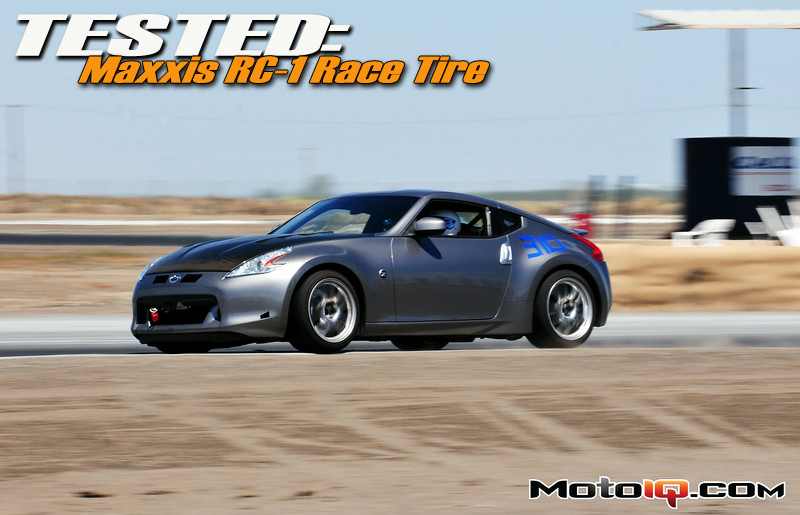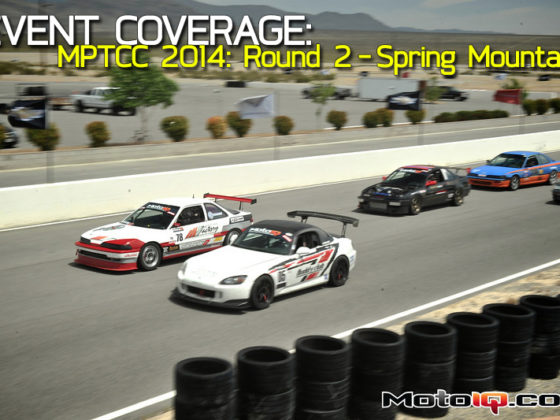,
Unlike other 100 UTQG treadwear R-compound tires in the market, the RC-1 has no tread design to speak of other than a simple DOT legal 2 line void area similar to softer compound 40 treadwear and under tires like the Hoosier R6/A6 and Hankook Z214s. Obviously this is not ideal for standing water traction, but it does save the trouble of shaving similar classed tires to their 2 line only tread depth, essentially getting the most for your money for dry events. The tire’s response potential is hinted before even driving because of their rigid sidewall and carcass construction while mounting on wheels. I ran the widest tire available in 18 inch sizes, 275/35/18, which is a very popular size in the track community. This is a bit undersized both width and overall diameter compared to what I am used to running on Project 370Z (285/35/18 Hankook RS3s), but should still perform fine because of the lack of void area in the tread design.
The smaller sidewall looks a little funny on Project 370’s large wheel arches, but the lower effective final drive with the smaller diameter is welcomed. That stiff construction I mentioned earlier is instantly noticeable driving on the street to the track. A bit uncomfortable on the long drives from LA to any of the “local” SoCal tracks, but I’m sure the tire’s rigidity will shine once on the race surface. I tested the tires over a period of 5 track events. One at the Autoclub speedway “Roval” configuration, three at Buttonwillow raceway park both clockwise and counter clockwise configuration “13” and clockwise at Chuckwalla valley raceway. Throughout the 5 events , I dealt with cool, cloud cover, sunny with optimum ambient temps, and 95 to 105 degree scorchers with killer track surface temps.
The first event on the RC-1s was at AutoClub Speedway “Roval” back in September 2013 when we did the Stillen brake duct test. Ambient temperature was hot from the get go, 90 degree before the drivers' meeting was even finished and got well into the 110s as the day went on. Not only was this the first time being on the Maxxis for me, it was also the first time in over 2 years since I had driven on the AutoClub Speedway surface. Needless to say, my first session was going to be cautious. Since the “Roval” configuration uses the oval turns 1 and 2 that NASCAR uses, the track is potentially very dangerous if underestimated. Also, Project 370Z has no aftermarket aerodynamic modifications. So the speed and stability through the NASCAR oval was going to be limited. During the first few laps of that initial session, the tires did not exhibit any poor behavior even though they were not fully up to operating temperature. This allowed me to get reacclimated to the track without having to worry about the tires doing anything weird. The communication through the steering was great, an attribute of the rigid construction I mentioned earlier. So initial impressions were positive. But once I had the jitters out of my system, I was eager to start leaning on the tires more to explore their abilities at and over the limit.
With the temperatures getting well over 100 come noon, I was a bit concerned on how the thermal capacity of the tires would be as I started to run faster in pace. The advertised optimum heat range of 140-210 degree F seemed more than capable to handle the day's conditions. But because of Project 370's soft suspension and substantial curb weight, I was still a bit concerned as to how consistent their grip level would stay after several laps in the heat. Lap after lap, the RC-1's proved my concern to be invalid. Throughout the rest of the sessions that day I never ran into issues with the tires getting “greasy”. The audible communication at the limit is great for a R-comp style tire. The sounds were very progressive as I approached the grip limit. Even under slip angle, it was very easy to control. The RC-1 honestly felt like a shaved street tire with high grip. Braking performance was exceptional and predictable, even with somewhat aggressive static camber settings. I wish my brake pads that day had had a more aggressive bite to fully utilize the tire grip. I was very pleased with how the tires performed their first time on track.
 Gruelling heat, street car weight, and an intense track configuration didn't even cause the RC-1s to break a sweat. Hopefully this level of performance was not just because the tires were fresh and new. A lot of high performance R comp tires do not have great longevity.
Gruelling heat, street car weight, and an intense track configuration didn't even cause the RC-1s to break a sweat. Hopefully this level of performance was not just because the tires were fresh and new. A lot of high performance R comp tires do not have great longevity.Here is a cool on board video in Project 370Z on the Maxxis RC-1s running the AutoClub Speedway “Roval” configuration. Also in the video are cameos from Mike Kojima in Project Sentra SE-R, and Martin Gonzales in Project Infiniti G20.
My Next event in October 2013 took me to Buttonwillow Raceway Park. Quite the popular track for both club racing and time attack. The twist this day was the track configuration NOT being the popular “Clockwise, #13”, it was actually counter clockwise which was how I first experienced Buttonwillow years ago. Configuration was still “#13”, but going counter clockwise throws off a lot of local drives because it is rarely ran. For me, it holds a special place in my heart so I was excited to drive. It had most likely been over 4 years since I drove Buttonwillow counter clockwise. Buttonwillow's variety of cornering speeds was going to give the RC-1 a great test. Weather was rather nice at a sunny 70 degrees. Even with the temps cooler in the morning, the RC-1's were still grippy enough to not get you in trouble before reaching optimum temperature. Buttonwillow has a lot of quick transitions, and the RC-1's responsive nature made Project 370 feel exceptionally nimble in such sections. I also got a more in depth experience with the tires at mild but high speed slip angles in the high speed corner sections of the track. Never at any point did the tire give me a false or vague reading. Throughout the day the heat cycles kept adding up, but it did not seem like the RC-1s got the memo. The grip stayed consistent the whole day.
 In the pits and dying to get on track and drive a rarely ran counter clockwise configuration at Buttonwillow Raceway Park. I was expecting the tires to hold up well since the weather was great.
In the pits and dying to get on track and drive a rarely ran counter clockwise configuration at Buttonwillow Raceway Park. I was expecting the tires to hold up well since the weather was great.More on board footage, this time for a couple laps going counter clockwise at Buttonwillow raceway park. The RC-1s were exceptional in transition and getting traction in low speed corner exits. The audio from the tires at the limit is easy to hear and read despite all the noise.



